Microsoft Surface Pro 2
11:43
Finally! Microsoft's second generation Pro tablet is
here, the Surface Pro 2. Why are we excited? There was much we loved
about Redmond's diminutive powerhouse, but battery life was abysmal,
making it a less than ideal 10.6" partner on the go. The second
generation Microsoft Surface Pro 2 has much better battery life thanks
to the fourth generation Intel Haswell Core i5-4200U. Haswell sips power
rather than guzzles, and the result is nearly doubled battery life
that's averaged 7 hours for us without draconian power savings.
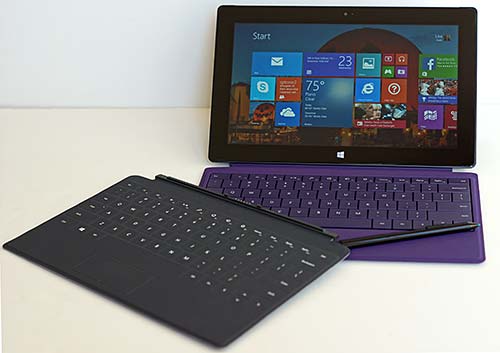
For those of you who are still
understandably confused by the Surface lineup, the Surface Pro 2 runs
full Windows 8.1 Pro 64 bit and it can handle anything that a
contemporary Ultrabook can do. You can install Photoshop CS or CC,
Skyrim and USB drivers meant for Windows. The 1.6GHz Core i5 dual core
CPU with Turbo Boost to 2.3GHz means Surface Pro 2 is a powerful laptop,
though it happens to look like a tablet. The Pro 2 is available with 4
or 8 gigs of dual channel DDR3L RAM, and your choice of 64, 128, 256 and
512 gig mSATA SSD drives. The price starts at $899, and the keyboard is
still an optional accessory.
Design-wise nothing has changed, and that's fine by us because the first gen Surface Pro
was a unique and cool looking piece of hardware. The VaporMg metal
casing, angled sides and integrated kickstand are here. The kickstand
now has two positions, one good for desks and the other for laps and low
tables. The fan is quieter and runs less often. Microsoft released the
Touch Cover 2 and Type Cover 2 with improvements as well: both are
backlit and easier to type on, particularly the Touch Cover 2 (the
original Touch Cover sometimes tried our patience). Windows 8.1 Pro is
pre-loaded with several improvements, including better handling of
display scaling and side-by-side Metro window views.
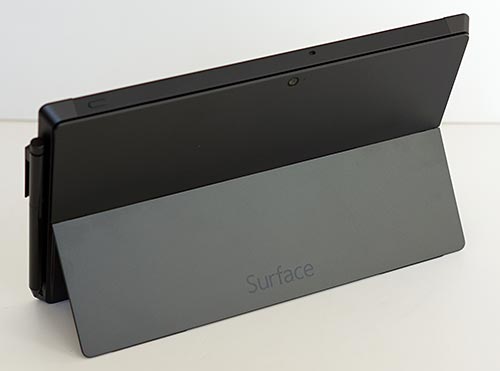
What's the same? It still weighs 2
pounds and is 0.53" thick. The display is still full HD 1920 x 1080, and
that suits us fine since 10.6" is too small for higher resolutions in
desktop mode. Microsoft claims the display has a much wider color
gamut, though in our tests, we wouldn't call it a huge difference. That
said, it's a lovely display and it still comes with the Wacom digitizer
and pen that's perfect for taking notes and doing art. You still get one
USB 3.0 port, a mini DisplayPort, stereo speakers and a 3.5mm combo
audio jack. The battery remains 42 Wh, and it's sealed inside. It has
the same Marvell 350N WiFi 802.11n dual band wireless (sorry, no WiDi
wireless display) and Bluetooth 4.0.
The design and color haven't changed
from the previous model, so we won't go over that again in detail.
Suffice to say this is a very well made machine with a sexy look and a
durable metal casing.
This is Not an iPad
Skip this if you read the section
heading and said "duh", this is for our computing novices. Apart from
the obvious price difference (or not since a 128 gig iPad with WiFi and
4G costs near $1,000), some folks can't tell an iPad
from an Android or Windows tablet. Even more complicated is that you
can buy a budget priced Intel Atom Windows 8 tablet for $500, which is
the same price as the base iPad and higher end 10" Android tablets.
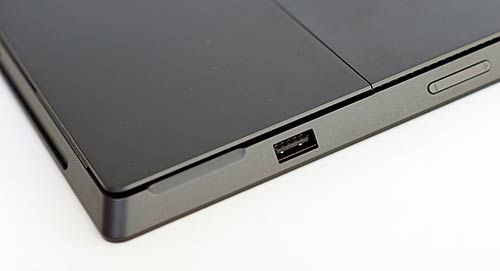
Though you can use Surface Pro 2 much as
you would an iPad for web surfing, email and playing videos and games,
it can do much more since it's a full Windows 8 PC. It has an internal
fan like a PC and runs for approximately 7 hours on a charge, while the
iPad and Android 10" tablets can run for 10 hours or more. It has a
compact laptop style charger rather than a small wall wart charger like
mobile OS tablets. It has enough computing power to run Adobe CS
programs well and it can multitask since it has 4 or 8 gigs of DDR3 RAM.
In comparison, a budget Windows 8 Intel Atom tablet has no fan, runs an
average of 8.5 hours on a charge, comes with a wall wart charger and
isn't a multi-tasking or computing genius since it has a slower CPU and
only 2 gigs of RAM. The Surface Pro line is for those who need the same
computing power you'd get from an Ultrabook like the Sony Vaio Flip 13, Acer Aspire S7 or the MacBook Air.
Type Cover 2 and Touch Cover 2
Microsoft revised both the Touch
and Type covers, and the first generation keyboards and second
generation are interchangeable in terms of compatibility with all
Surface and Surface Pro models. The Type Cover 2 has traditional moving
keys, as did the Type Cover, but the new model adds multi-level
backlighting with a proximity sensor (put your hands above the keys and
they light up). It switches from a hard surface trackpad with clickers
to a fabric style trackpad with no mechanical buttons. Key travel is
slightly deeper on the Type Cover 2 and I'd pick it over the first gen
model unless you're tempted by a great clearance sale on the original
Type Cover. It's available in black and colors like purple.
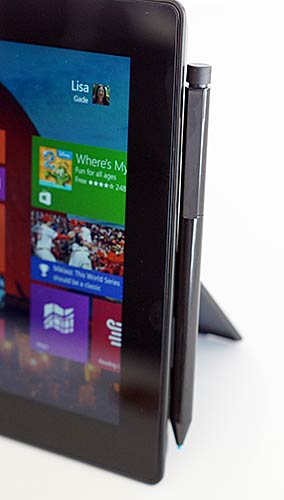
The Touch Cover 2 is a huge
improvement over the original Touch Cover. It's much more sensitive so
you can type more naturally without working hard to activate each
pressure sensitive key. This is a fabric surface keyboard (it feels
something like short nap suede) and the keys have ridges around the
edges for tactile feel but they don't move. The Touch Cover 2 is a few
ounces lighter than the Type Cover 2, but both are quite light. Like the
new Type Cover 2, the Touch Cover 2 has multi-stage backlighting and a
proximity sensor. The Touch Cover 2 is actually very usable and I
haven't run back to the Type Cover 2 when I need to type a few emails or
enter URLs. I'd definitely buy the Touch Cover 2 rather than the
original Touch Cover, even if you find the old model on clearance.
Both Touch and Type Covers
function as display covers and will put the tablet to sleep when you
close the cover. The keyboard covers clip onto the Surface Pro and Pro 2
using very strong magnets that don't let go even if you suspend the
tablet by the keyboard (not that we recommend doing so), but it's easy
to disengage with an intentional twist motion from either end where the
keyboard mates with the tablet.
Microsoft now sells an accessory that connect the Touch Cover 2 and Type Cover 2 with the Surface 2
and Surface Pro 2 over Bluetooth just in case you'd rather have the
tablet on a table and the keyboard on your lap. But for the $40 MS
charges, you could also buy a larger Bluetooth keyboard. Note that the
covers themselves use a mechanical connection to the tablet, not
Bluetooth, so you'll need Microsoft's accessory if you want to use them
over Bluetooth.
Display
This is a small laptop-tablet
hybrid with a small 10.6" screen. If you're accustomed to 10" tablets,
it won't feel that foreign or tiny, but if you've been using 15" or even
13.3" laptops, you might find it hard to adjust to the smaller display.
In its favor, this is a very sharp full HD 19120 x 1080 display with
high pixel density (among laptops and tablets). That means text and
graphics are very sharp and you'll be hard pressed to see individual
pixels.
This is an IPS panel with wide
viewing angles and it uses bonded Gorilla Glass to reduce reflections,
though we still saw plenty of reflections on the glossy panel.
Brightness is excellent at 390 nits according to our Spyder Pro
colorimeter, and contrast is very good at 670:1. Despite some glare, the
panel is bright enough to combat bright light and it's viewable
outdoors, though you'll notice some fade.
Though Microsoft bragged about
significantly improved color accuracy, that didn't translate into much
improved color gamut. Sure, color tuning out of the box is very good for
a laptop or tablet, but the Surface Pro 2 can't compete with the Sony Vaio Pro and Vaio Duo 13, Samsung ATIV Book 9 and Samsung ATIV Book 9 Plus
or the late 2013 MacBook Pro 13" with Retina display. That doesn't mean
the Surface Pro 2 has poor colors--in fact it looks great when viewing
photos and full HD videos with vibrant and lifelike colors. It simply
won't display as wide a range of hues as the best panels on the market,
which is important to graphics professionals who edit images and video
for commercial use. The Surface Pro 2 covers 72% of sRGB (vs. 95% for
the top competitors we listed) and 54% of Adobe RGB (vs. 75% for those
same top competitors). That still compares well with the lovely Acer
Aspire S7 and Acer Iconia W700, and far surpasses most laptops on the
market.
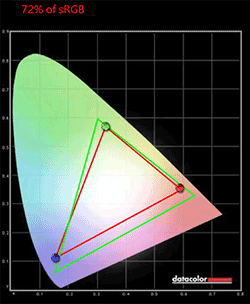
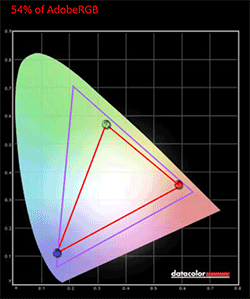
Wacom Digitizer and Pen: for the Artists and Note Takers
If you've ever tried a capacitive
stylus on an iPad or Android tablet, you know it's not a rewarding
experience. There's no pressure sensitivity, the tips are fat and thus
not precise, and there's no palm rejection (if you lean your hand on the
screen while writing with the stylus you'll get vectoring, or random
lines). The Wacom digital pen is much better because it has 1,024 levels
of pressure sensitivity (press hard and you'll get a fat line or paint
stroke), palm rejection and the tip is accurate and precise. If you're
an artist who paints or sketches, the Surface Pro 2 should be on your
short list, especially since Wacom is well supported by Adobe and Corel
art programs. You'll need to download Wacom's Feel It drivers from their
website to get WinTab support for these programs, but ArtRage,
Sketchbook Pro and MS Office including OneNote support pressure
sensitivity with no need to download additional drivers. Note takers
will also appreciate the digital Wacom pen for its accuracy and palm
rejection.
Edge accuracy has improved over
first generation Windows 8 tablets with Wacom, one area where N-Trig had
the advantage. The pen tracks well at the very edges of the screen on
our unit (we loaded Wacom's Feel It drivers). As with the last gen
Surface Pro, the included pen clips onto the magnetic charging port for
transport (unless you're charging the Surface Pro 2). It's a tablet PC
pen, so pens made for other tablet PCs and even Samsung Note products
work with the Surface Pro 2.
Performance and Horsepower
At the risk of beating the topic
to death, this is an Ultrabook in tablet clothing, and that means it's a
fast performer that can do anything you'd expect a laptop to do. It's
quick and handles MS Office 2013, Photoshop, Illustrator and Premiere
well. You can use it for software development and it multitasks like a
champ. The base model has 4 gigs of DDR3L RAM and the mid and upper
level configurations have 8 gigs of RAM. For Photoshop, Office and video
playback 4 gigs of RAM really is fine. If you intend to run several
heavy hitting programs at once or are worried about future proofing,
then the 8 gig model is a fine choice. The mid level model is
competitively priced and that nets you 8 gigs of RAM and a 256 gig SSD
for $1,299.
The $899 base model has 4 gigs of
RAM and a 64 gig SSD, and 64 gigs is really too small since Windows, the
standard Windows programs and the recovery partition eat half of that.
We recommend the $999 configuration with 4 gigs of RAM and a 128 gig
SSD, which matches what you get with most Ultrabooks today. Regardless
of configuration, the Surface Pro 2 comes with the Intel Core i5-4200U
1.6GHz dual core CPU and Intel HD 4400 graphics. This is the latest
generation Intel Haswell platform that offers modest graphics
improvements over the outgoing Ivy Bridge and much better battery life.
There is no i7 option, but honestly the performance gains are slim with
the i7 ULT ultra-mobile 15 watt CPU family.
The Surface Pro 2 isn't easy to
open for do it yourself upgrades. RAM is soldered and isn't upgradeable,
while the SSD is a standard mSATA drive (sorry, not the newer and
faster PCIe interface). The dual band wireless card with Bluetooth is
socketed. Since opening Surface involves a heat gun to lift the display
from the casing, we don't recommend you open it up. Should the tablet
require service or an eventual battery replacement, we suggest you send
it to Microsoft for service.

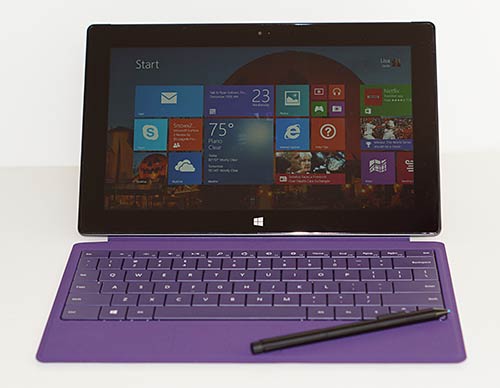

0 comments